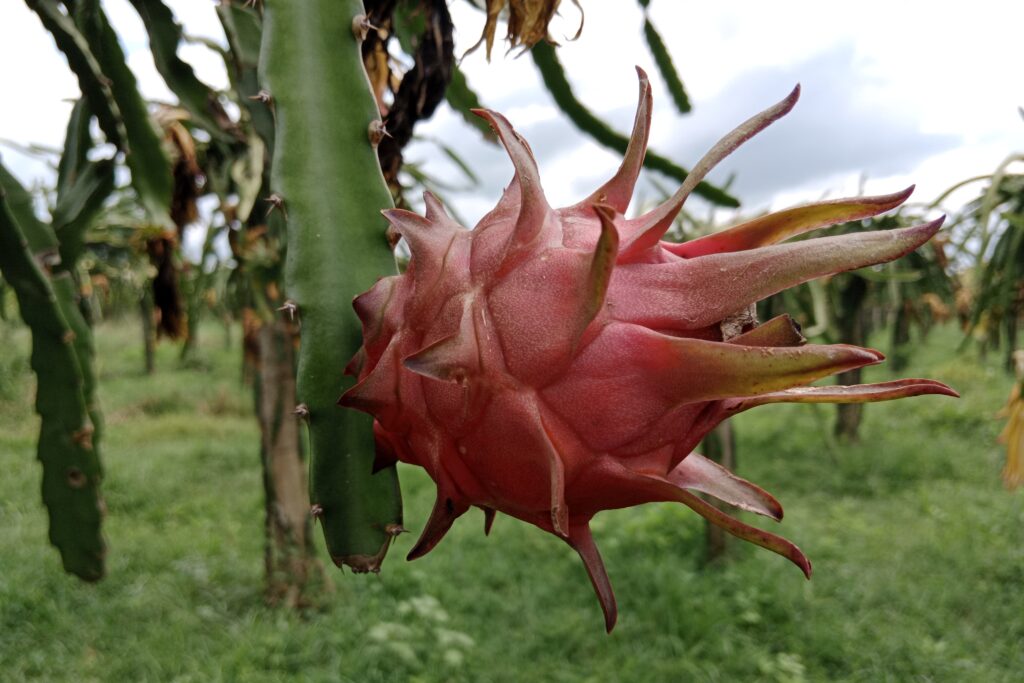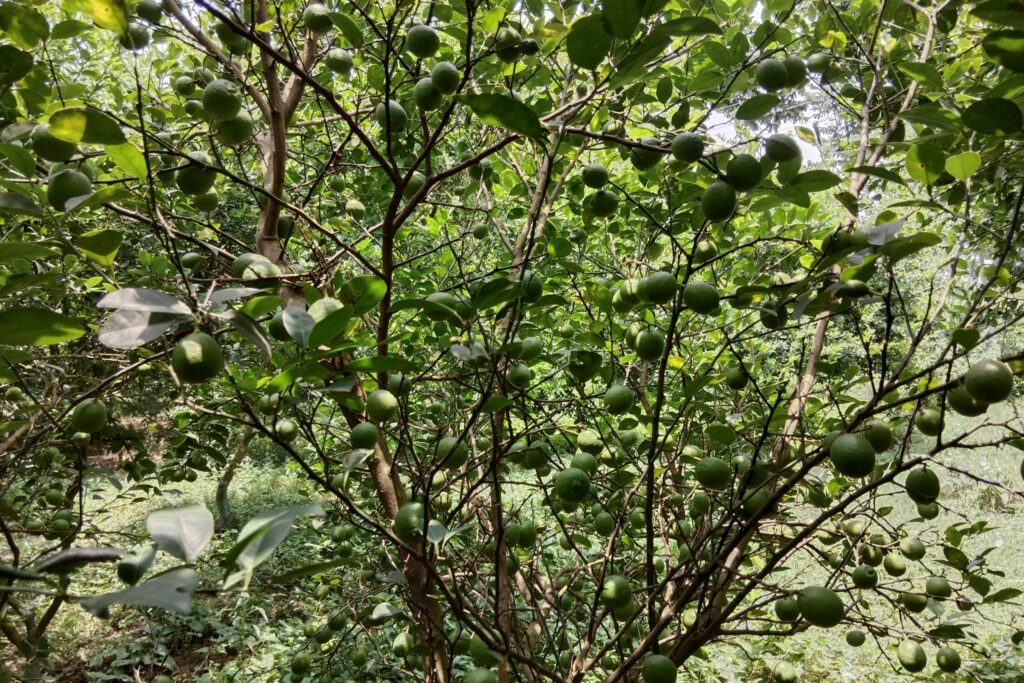Radish Farming
Radish farming offers significant economic potential, with a net profit per acre of NRs. 77,000. This is derived from deducting a total investment of NRs. 43,000 from the gross income of NRs.120,000. Such profitability translates to an impressive profit margin of 179.07%, highlighting the crop’s ability to deliver high returns on investment.
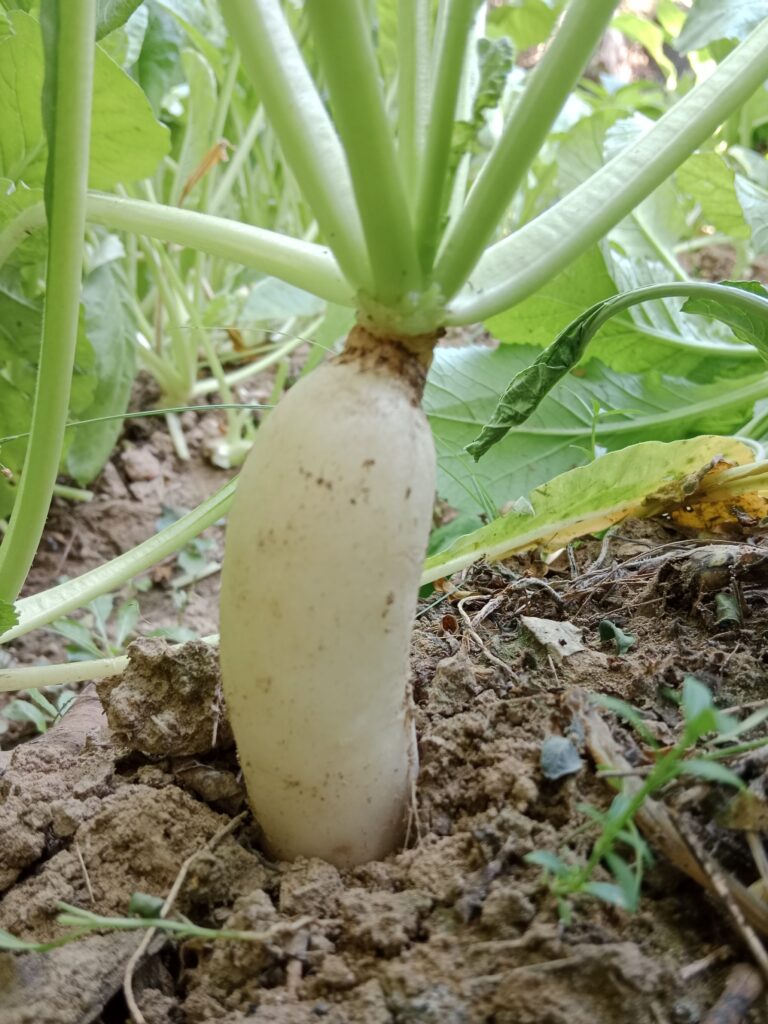
Additionally, the cost-benefit ratio of 2.79:1 further underscores the economic efficiency of radish farming, meaning that for every rupee spent NRs. 2.79 is generated in revenue. The robust financial metrics of radish farming profit per acre reflect the viability of radish cultivation as a profitable venture for farmers, particularly when combined with proper agronomic practices and market strategies. This makes radish farming an attractive option for both small-scale and commercial agricultural enterprises.
Land Preparation
Land preparation begins with initial deep plowing (15-20 cm or 6-8 inches) to break up compacted soil and significantly improve aeration. This is followed by repeated harrowing (2-3 times) to thoroughly break down any remaining soil clods, effectively incorporate organic matter or manure, level the field surface, and create the desired fine tilth suitable for seeding.
Concurrently or immediately after, it’s essential to clear the field of stones, weeds, and old plant residues to provide a clean seedbed and minimize competition and disease risks. Finally, based on soil drainage characteristics and expected rainfall, the field is formed into either raised beds or flat beds; raised beds (10-15 cm high) are particularly recommended for heavy soil or in areas prone to wet conditions to enhance drainage and prevent waterlogging around the developing roots.
Soil Type
The best soil for growing radish is deep, loose, sandy loam or loam, which is valued for its good drainage that keeps roots from rotting, its ease of root penetration and extension that keeps roots from becoming deformed, its capacity to warm up rapidly in the spring, and its overall workability.
Although silt loam that drains well is a suitable substitute, heavy clay soils should be avoided because of their propensity for compaction and poor drainage, which result in forking and deformed roots; stony soils should also be avoided because they cause deformed roots; and poorly drained soils should be avoided because they encourage rot. Fertilization is important, but too much nitrogen should be avoided since it encourages excessive top growth at the expense of root development.
Climatic Requirements
The ideal growing temperature range for radish, a cool-season crop, is 10–18°C (50–65°F). The plants do well in cool, damp weather, but when exposed to hot weather above 21°C (70°F), their roots become woody, pungent, and prone to cracking.
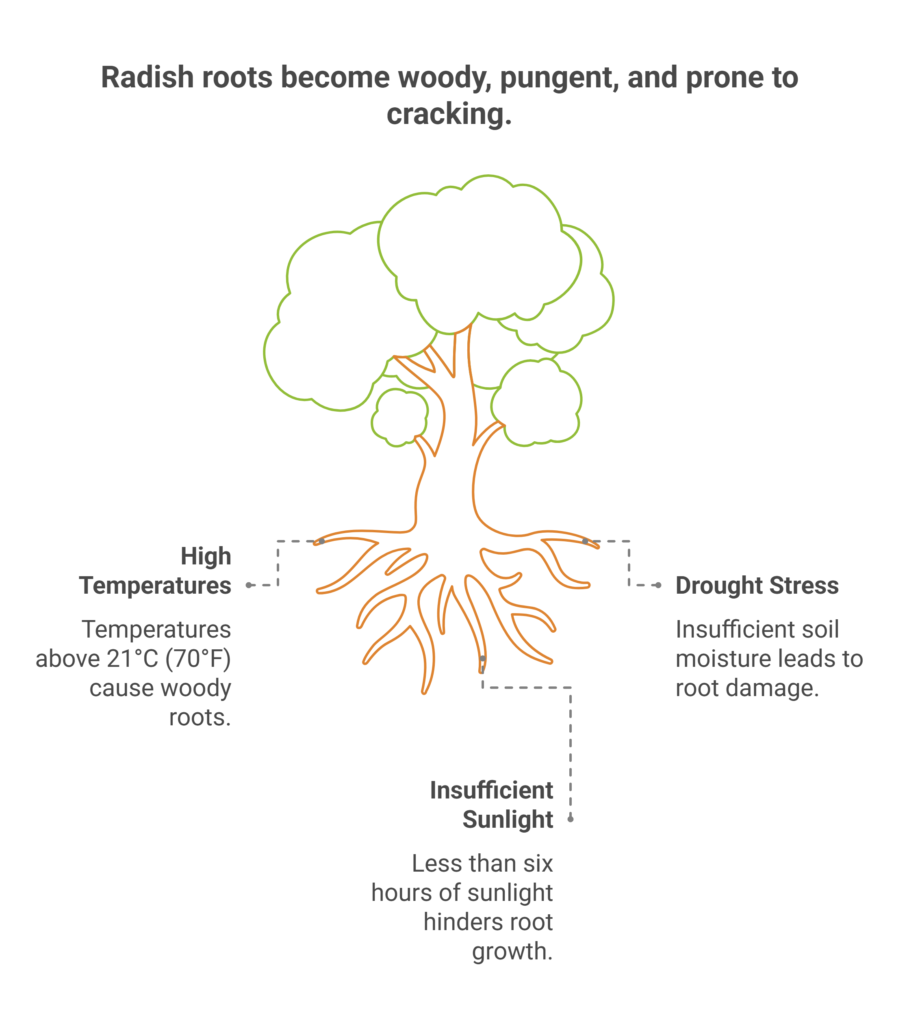
Although they can withstand light frosts, seeds can germinate as low as 4-5°C (40°F), but germination is best between 15-30°C (60-85°F). Radishes need full daylight, or at least six hours of direct sunshine per day, for optimal root development. Although evenly distributed rainfall is advantageous, irrigation is typically required to maintain sufficient soil moisture. This is because drought stress causes woody, smelly, and damaged roots.
Major Cultivars
| Type | Cultivar | Characteristics |
| European Types | Cherry Belle | Round, bright red skin, white interior; classic salad radish |
| (Small, Round/Globe/Oblong, Fast-Maturing) | French Breakfast | Oblong shape, red skin with white tip; mild flavor |
| Sparkler | Round shape, red skin with white tip | |
| Easter Egg Mix | Blend of round radishes in white, pink, red, and purple | |
| White Icicle | Long, tapered shape; pure white; mild flavor | |
| Asian Types | April Cross | Large, long, white daikon |
| (Large, Long/Cylindrical, Slower-Maturing – Daikon) | Minowase | Very large, long, white daikon; sweet and mild |
| Red Meat/Watermelon | Round or oblong; green/white skin, bright pink/red interior; mild flavor | |
| Chinese White | Cylindrical shape; pure white |
Seed Rate
For sowing one acre of land, a seed rate of 4-5 kg is sufficient; this quantity of seeds is sown on ridges to ensure proper root development and optimal growth conditions for the radish crop.
Planting
a). Planting Season
The primary planting seasons for radish are the cool periods of spring, sown as soon as the soil can be worked, and autumn/fall, typically planted 6-8 weeks before the first expected frost; while winter planting is possible in mild, frost-free climates like coastal regions, midsummer heat must be strictly avoided as it leads to premature bolting (flowering) and the development of poor-quality, undesirable roots.
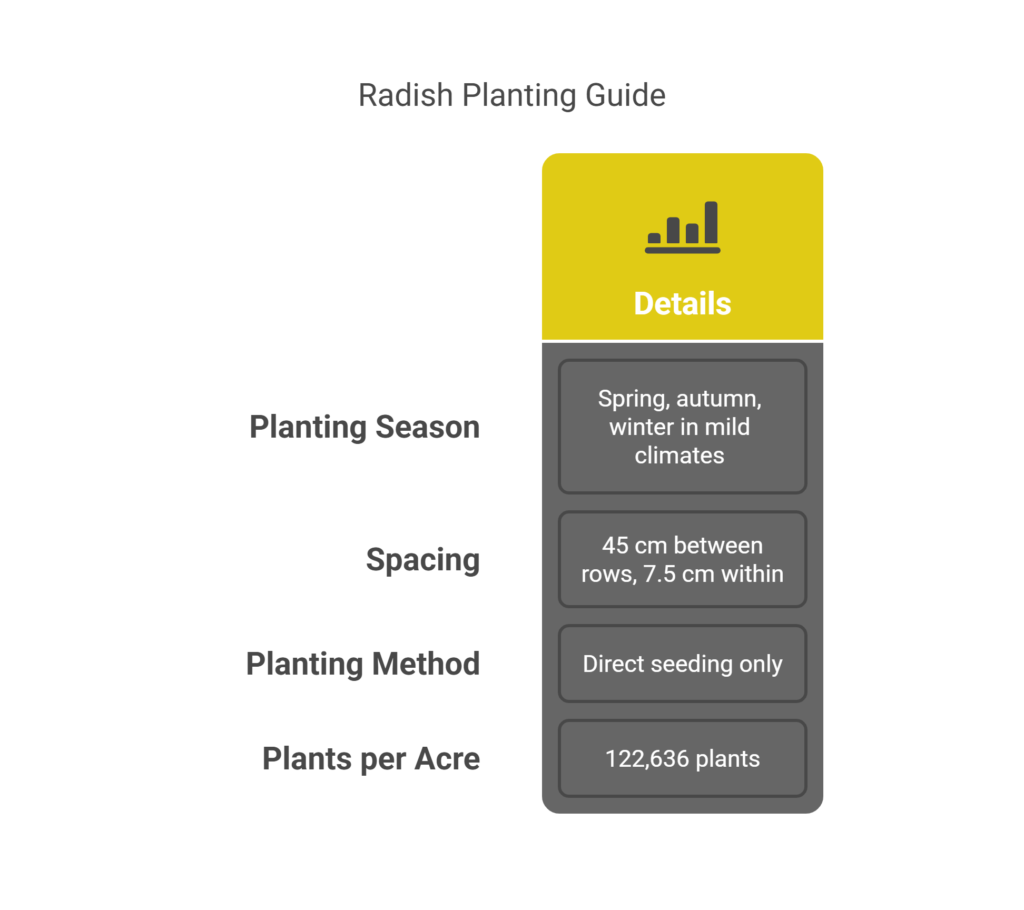
b). Spacing
Planting requires spacing of 45 cm between rows and 7.5 cm within rows, with seeds sown at a depth of 1.5 cm.
c). Planting Method
Radishes must always be established by direct seeding, as they do not tolerate transplanting well due to the inevitable root disturbance; seeds are sown thinly, either in precise rows or shallow drills, and on small-scale beds, they can be sown followed by subsequent thinning to achieve the proper plant density.
d). Number of Plants per Acre
Based on the specified spacing, 122,636 plants per acre can be accommodated.
Irrigation
For soft, mild radish roots, regular soil hydration is essential to avoid pithiness or cracking. In dry weather, light, regular watering every two to three days helps prevent stress, particularly during root development. Watering is done every 6-7 days in the summer and every 10-12 days in the winter, for a total of 5–6 irrigations depending on the soil and climate.
The initial irrigation helps with germination. For effectiveness and disease prevention, drip irrigation is recommended. Steer clear of overwatering to avoid excessive hair growth and malformed roots. A final light summer irrigation maintains freshness and lowers pungency, while a slight water reduction two to three days prior to harvest firms roots.
Fertilizer and Manure
| Category | Specifications |
| Nutrient Needs | Moderate feeders. Prioritize P and K for root development. Avoid excess N (promotes leafy tops, reduces root quality, risks hollow roots). |
| Basal Application (Before Planting) | • Organic: Incorporate 6–8 tons/acre well-rotted compost during land prep. • Inorganic: Apply balanced NPK fertilizer based on soil test: – N: 18–23 kg/acre – P₂O₅: 23–32 kg/acre – K₂O: 23–32 kg/acre |
| Top Dressing | • Generally, not required (short growing season). • If needed (e.g., poor growth): Apply 6 kg N/acre as side-dressing early in growth. |
Weed Control
Weed control is crucial for radishes as weeds compete for light, water, and nutrients. Effective strategies include mulching with a thin layer of organic material like straw or compost after seedlings emerge (avoiding thick layers to ensure germination), hand weeding within rows after thinning, and shallow cultivation between rows to protect shallow roots. While chemical weed control is often avoided in small-scale or organic systems, pre-emergence herbicides may be used in large-scale production if label guidelines for radishes are strictly followed.
Pest and Disease Management
Common Pests

a). Flea Beetles
For flea beetles and mustard sawfly infestations in radish fields, immediately apply a spray of Malathion 50EC at 1 ml per liter of water upon detection; repeat this treatment 2–3 times at 10-day intervals to ensure effective pest control.
b). Root Maggots
Root maggots are a serious pest whose larvae tunnel into radish roots, causing direct damage; effective control requires crop rotation (avoid brassicas for 2+ years), installing floating row covers pre-emergence to block egg-laying adults, applying beneficial nematodes as a soil drench to target larvae, and using targeted insecticides when infestations occur.
c). Aphids
This major radish pest attacks crops at both seedling and maturity stages. If infestation occurs, apply Malathion 50EC at 1 ml per liter of water as a spray treatment. Repeat applications 2-3 times at 10-day intervals for effective control.This major radish pest attacks crops at both seedling and maturity stages. If infestation occurs, apply Malathion 50EC at 1 ml per liter of water as a spray treatment. Repeat applications 2-3 times at 10-day intervals for effective control.
d). Cutworms
Cutworms cut radish seedlings at the soil line during night feeding; while protective collars around transplants are rarely used for direct-seeded radishes, effective control relies on nightly hand-picking of larvae, applying bait formulations, and removing daytime hiding spots like weeds or debris near plants.
Common Diseases
a). Alternaria Blight
Alternaria blight appears as slightly raised yellow spots on radish leaves, spreading rapidly during rainy conditions; the fungus can infect pods, causing seeds to lose viability. Upon detecting infestation, apply a spray of Mancozeb (2g/liter of water) or Carbendazim (1g/liter of water) to effectively control this disease.
b). Powdery Mildew
A white powdery covering that usually covers the surface of leaves is the hallmark of powdery mildew, a fungal disease that may lower photosynthesis and plant vitality. Neem oil is an organic therapeutic alternative, fungicides are used to control the infection, and resistant plant kinds are cultivated to prevent the disease. The conditions that encourage its growth can also be reduced by making sure that plants are spaced appropriately apart and that there is adequate air circulation.
c). Clubroot
Clubroot, a fungal disease affecting rutabagas and cole crops, is commonly found in soils with a long history of brassica cultivation. The fungus can persist in the soil for over seven years after an infected crop, and certain mustard-family weeds, such as wild radish and wild mustard, can sustain or increase soil infestation levels. Controlling these weeds is crucial to managing the disease. Preventive measures include avoiding infested soil and raising the soil pH to 7.0 or higher before planting. Additional guidance on managing clubroot can be found in the cole crops section of this guide.
d). Root Rots (Fusarium, Rhizoctonia)
Root rots caused by pathogens like Fusarium and Rhizoctonia lead to symptoms such as root decay and plant wilting, which can significantly impact crop health and yield. These diseases thrive in poorly drained, waterlogged soils and are often exacerbated by overwatering. Effective management strategies include improving soil drainage to prevent water accumulation and adopting proper irrigation practices to avoid excess moisture.
Crop rotation with non-host plants can disrupt the life cycle of these pathogens, reducing their prevalence in the soil. Additionally, the use of fungicides can help manage infections when applied as part of an integrated disease management program. Maintaining healthy soil conditions and avoiding stress on plants are also critical to minimizing the risk of root rots.
Harvesting
Timely harvesting is crucial for radishes to maintain quality, as delays can lead to woody, pithy, cracked, or overly pungent roots. The ideal harvest time varies by cultivar, usually 22–60 days, with maturity indicated by the expected root size, a plump appearance, and the crown pushing slightly above the soil—sampling ensures precision.
Harvesting involves hand-pulling the foliage near the crown or using a garden fork or spade for firmer soils, particularly with Daikon varieties. Yields can reach about 12 tons per acre within 45–60 days. Post-harvest, tops should be removed immediately to minimize moisture loss, roots gently washed to remove soil and cooled quickly through hydro-cooling or ice water. Proper storage at 0°C (32°F) with 95% humidity helps maintain freshness and crispness for several weeks.
Cost of Investment for Radish Farming Per Acre
| S.N. | Categories | Cost (NRs) |
| 1 | Land Preparation (plowing, levelling) | 15,000 |
| 2 | Seed rate per acre | 2,000 |
| 3 | Labor Costs (transplanting) | 3,000 |
| 4 | Fertilizers and Manure | 7,000 |
| 5 | Irrigation | 4,000 |
| 6 | Weed Control | 2,000 |
| 7 | Pest & Disease Control | 5,000 |
| 8 | Harvesting | 2,000 |
| 9 | Miscellaneous Costs | 3,000 |
| Total Cost | 43,000 |
Income from Radish Farming Per Acre
| Particulars | Estimated Yield (kg/acre) | Market Price (NRs/kg) | Total Income (NRs) |
| Radish yield | 12,000 | 10 | 120,000 |
Analysis of Radish Farming Profit Per Acre
Radish cultivation offers significant economic potential, with a net profit per acre of NRs.77,000. This is derived from deducting a total investment of NRs. 43,000 from the gross income of NRs.120,000. Such profitability translates to an impressive profit margin of 179.07%, highlighting the crop’s ability to deliver high returns on investment.
Additionally, the cost-benefit ratio of 2.79:1 further underscores the economic efficiency of radish farming, meaning that for every rupee spent NRs. 2.79 is generated in revenue. This favorable ratio reflects the viability of radish cultivation as a profitable venture for farmers, particularly when combined with proper agronomic practices and market strategies.
The robust financial metrics make radish farming an attractive option for both small-scale and commercial agricultural enterprises.

